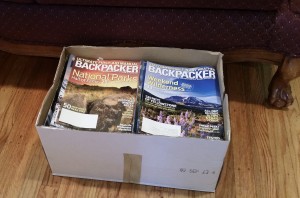 Is this the year you’re planning to make your big move? Have you been saving to buy a home? Thinking about retiring and downsizing? Planning on a job change? Want to move closer to the grandkids?
Is this the year you’re planning to make your big move? Have you been saving to buy a home? Thinking about retiring and downsizing? Planning on a job change? Want to move closer to the grandkids?
Whatever the reason, there are things you can and should assess and address. One big consideration is the cost. Between packing materials, moving trucks, mileage and manpower, a relocation can run anywhere from 2- to 10-thousand dollars. While some pull it off on a shoestring and others exceed that 10K mark, it is most certainly a costly venture. So what can you do now to identify and avoid unnecessary expenses?
One thing is to take a discriminating look at what, in fact, will have to be moved. This small box of magazines weighs more than 40 lbs! At an average charge of $.50 per pound, that’s $20 (and that’s not even taking into account the labor charge for loading and unloading it). An online subscription to this Backpacker magazine is only $27…for 3 years! Are you sure these magazines, (broken printers, outgrown bikes, etc.) are worth that much to you?
Save your sanity and your budget by lightening your load now. Here are some easy target areas:
- Books – books are heavy. Really heavy. Easy purges are old phone books, old college textbooks and test-prep books (like SAT prep). In this digital age, these written tomes are outdated almost as soon as they are printed. Now is also a good time for a stringent review of each family member’s literary collection.
- Coats – heavy, bulky clothing is going to cost more to move. Garment boxes are expensive – more than 7-times as expensive as large moving boxes!
- Garage – take only outdoor toys and sports-equipment that are current and in good working condition. Return borrowed items to your neighbors – while you’re at it, give them the opened bags of potting soil, grass seed or fertilizer. Keep only tools in good repair (not the weed-whacker with the broken motor). Be sure that the toolbox is intact, containing items that will be helpful when you unpack in your new home: Phillips- and flathead-screwdrivers, hammer, nails, picture hooks and box-cutters are a must.
- Pantry – start grocery shopping at home and use or lose some of the oldest items. Now is not the time to shop in bulk. Use your backup supplies. Canned goods and bottled drinks can be repurchased later but are especially heavy items that will add undue and costly weight.
- Under the sinks – are there bottles of cleaners, lotions and other, perhaps unidentifiable, items that haven’t been used in ages? Use what you can and toss what you know you will never use. Who wants to unpack a sticky mess of toothpaste and drain cleaner anyway? Yuck.
- Shoes – take a look. If they are outgrown, worn out or missing a mate, part with them now. They’ll only bring aggravation and dirt along for the ride.
Want to know how much you’ve saved by being prepared in advance? Step on the scale with each bag or box you remove and keep track in a notebook or on your cell phone.
Whether you are using a moving company or hauling the load yourself, more stuff means more weight, more time and, bottom line, more money. Since costs incurred in any move include volume, weight and time, the less that is spent on packing and hauling your possessions, the more there will be for other discretionary expenses like unpacking, cleaning, window treatments or furniture updates.
Click on the title above to learn more about the featured author.





I super like these target areas you presented. I am learning a lot!